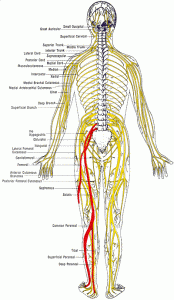Sciatic Pain- How to get relief! Part 1
 When I was in massage school, we were taught that sciatica (shooting nerve pain that travels down the back of the leg) was most often caused by a tight hip rotator muscle called the piraformis ( a muscle in the gluteal region of the lower limb). The piraformis connects our tailbone (or sacrum) to the top of our femur (or leg bone) and when contracted or when the muscle constricts, pulls the leg and knee to the side away from the body, opening the hip. Since this muscle crosses over the sciatic nerve, if it is overly contracted then it can pinch the nerve and cause pain. If someone came in complaining of sciatic pain, I would release their piraformis during the session using several techniques including deep tissue massage and body rebalancing.
When I was in massage school, we were taught that sciatica (shooting nerve pain that travels down the back of the leg) was most often caused by a tight hip rotator muscle called the piraformis ( a muscle in the gluteal region of the lower limb). The piraformis connects our tailbone (or sacrum) to the top of our femur (or leg bone) and when contracted or when the muscle constricts, pulls the leg and knee to the side away from the body, opening the hip. Since this muscle crosses over the sciatic nerve, if it is overly contracted then it can pinch the nerve and cause pain. If someone came in complaining of sciatic pain, I would release their piraformis during the session using several techniques including deep tissue massage and body rebalancing.
In these sessions, the piraformis release “hurts good” at the time of the session but the clients often don’t receive lasting benefits from this release. A tight piraformis does not live on its own; it often a symptom of an imbalanced structure. Though we can get the piraformis to release and let go, if this is not done within a session where all the muscles of the hips contributing to a pattern are also released so the body can find a new way to balance more efficiently. Then the body will often return back to the starting pattern and sciatic pain returns. Addressing pain as a symptom of structural issues is our objective at Surgical Alternative. We utilize SET Bodywork release the muscles and rebalance the body.
This became very clear to me once I started to study structural approaches to pain rehabilitation. The piraformis, I discovered, is certainly not the only culprit to sciatic pain. Determining how to most effectively address this issue depends on adequate evaluation of the body’s structure. This is way we first visually assess the structure by observing the client standing so their weight-bearing structure emerges. Almost every client I have seen reporting a painful condition presents an imbalance in the pelvis with one side rotating forward and one rotating backward.
Although massage has been around for hundreds of years we are still discovering the power the body and mind having in the healing process. I have seen and lived this process with many of my clients, that is why I feel very fortunate and excited to do what I love to do, help others that are suffering from herniated discs, bulging discs, hiatal hernias, peripheral nerve damage, nerve entrapments, pinched sciatic nerve issues and many more symptoms that people think they either have to have surgery for or are told they just have to deal with the pain. At www.surgicalalternative.com we can help! Check back for Part II